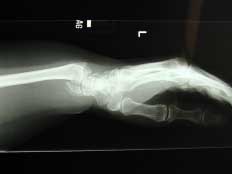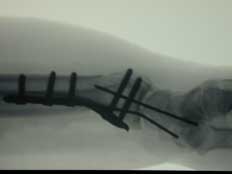Hand or wrist fracture surgery is necessary to realign and secure broken bones of the hand and wrist that cannot be treated with conservative approaches.
Hand or wrist fractures are common injuries in which the bones that make up the hands or wrist break. Most hand and wrist fractures happen after falling onto an outstretched hand. Motor vehicle accidents, work-related injuries and sports injuries are other common causes of hand and wrist fractures.
There are 27 bones in the hand and wrist, forming three distinct groups:
The majority of hand fractures affect the metacarpal bones, especially those found at the outer edge of the hand. These account for up to 40% of all hand fractures.
Hand and wrist fractures vary in severity, from stable fractures where the broken bones are aligned to unstable fractures where bone fragments have shifted and even open fractures where there is also a break in the skin. The severity of the fracture determines the optimal course of treatment.
A hand or wrist fracture typically leads to:
Because this type of injury can result in loss of hand mobility, treatment is nearly always necessary.
Most hand and wrist fractures are stable and can be treated without surgery, usually with the help of splints or casts. Less severe unstable fractures can be treated with minimally invasive approaches using wires and pins.
When broken bones have significantly shifted, when there are many bone fragments or when the fracture punctures the skin, surgery is needed to realign the bones to ensure proper healing takes place.
Surgery is sometimes required to restore bone alignment after a hand and wrist injury. To achieve this, surgeons typically use hardware such as wires, plates and screws. These medical devices are secured to the fractured bone to realign it and hold it in place as it heals.
Surgery is performed under local, regional or general anesthesia depending on the surgical technique used, the severity of the fracture and your general health.
Surgery typically takes 30 minutes to 1.5 hours to complete. Patients usually go home on the day of their surgery to continue their recovery. Immediately after surgery, most patients need to wear a splint for one to two weeks. Hand therapy may be required afterward, with additional splinting, exercises and strengthening to restore the highest function.

Candidates for hand or wrist fracture surgery typically present with severe fractures characterized by:
In such cases, surgery ensures normal healing and helps preserve hand mobility. With open fractures, surgeons will also remove debris and dead tissue to prevent infections.
Hand surgeons look at patient symptoms and carefully examine the hand for sensory and motor dysfunction to determine if surgery is necessary. Patients also require X-ray and CT or MRI imaging to carefully examine the scope of the injury and help decide on the best treatment.
Before surgery, you will undergo a series of preoperative tests and scans. These may include imaging tests, physical exams and blood tests.
On the day of your surgery, you should avoid all food and drink. We may also ask you to discontinue certain medications and supplements in the days leading up to surgery. The facility where we schedule your surgery will reach out to discuss which medications to continue or to stop. Plan to take some time off work and arrange for a drive back home.

You will be lying down with your hand extended sideways. The anesthesiologist will administer anesthesia. Your hand will be cleansed and sterilized before the operation begins.
Once the anesthesia takes effect, your surgeon will make an incision at the place of your injury to access the broken bone. They will then reposition the bone so it aligns properly and secure it with screws or plates using a special drill. In some cases, incisions are not necessary, and the bones are secured using pins. These pins are usually left outside the skin, but occasionally underneath the skin, and will be removed at a future date.
After the incision is closed with stitches, the hand will be covered in bandages and secured in a protective cast or splint.
Patients usually go home on the day of their surgery to continue their recovery. At home, it is important to follow your doctor’s instructions:
You will have a follow-up appointment a week or two after surgery to remove your bandages, stitches or pins. You will meet with an occupational therapist who will give you a new splint and recommend therapy exercises to help you regain normal movement of your hand.
Complications following hand or wrist fracture surgery are rare. When they do occur, they may include infections, nerve damage, failure of bone healing and problems with hardware.
Because we use anesthesia for this procedure, you will feel no pain during surgery. We will also offer a pain management strategy after your surgery to keep you comfortable.
Most hand fractures take four to eight weeks to heal. More severe fractures may take longer. Full recovery, where you regain strength and flexibility of your hand, usually takes place within six months.
You will need to take some time off work to recover. How much time depends on your occupation. Physically demanding jobs mean longer downtime compared to office work.
Once your hand or wrist has healed, avoid lifting anything heavy for at least six weeks and do not lean on your hand.
Hand and wrist fractures can cause significant pain and disability if not treated properly. At Plastic Surgery Austin, we regularly perform hand and wrist fracture repair using the latest techniques and technology to maximize patient outcomes.
Contact Plastic Surgery Austin today to schedule a consultation with Dr. Sharma. He will help you decide on the best course of treatment so that you can recover your full range of motion with minimal risk of complications.
Call us at 512-838-3658 or connect with us online now!
Contact our office to schedule a private consultation with Board Certified Plastic Surgeon, Sanjay K. Sharma, M.D., F.A.C.S.